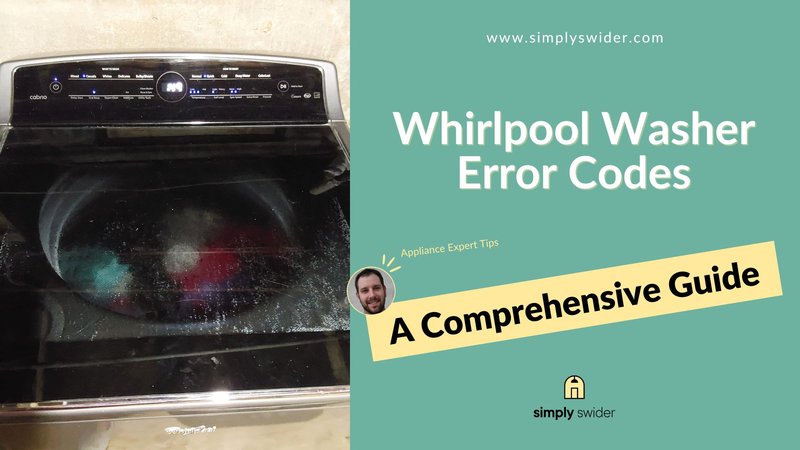
This isn’t uncommon. Modern appliances, like your Whirlpool dryer, are equipped with error codes to help diagnose problems. The E3 error code, in particular, signals an issue with the moisture sensor, which is crucial for your dryer to detect when your clothes are dry. Ignoring this isn’t just a push of the “continue” button away. It’s like having a warning light on your car dashboard—sometimes it could be nothing, but often, it signals something that needs attention to avoid bigger issues down the road.
Understanding the E3 Error Code
So, what exactly is the E3 error code all about? Think of your dryer as a baking oven; instead of a timer, it relies on a moisture sensor as its guide. The E3 code appears when the dryer’s control board senses a problem in reading the moisture levels. Essentially, it’s saying, “Hey, I can’t tell if your clothes are dry!” This can happen because the sensor is faulty, there’s a blockage, or even an electrical hitch.
A moisture sensor works like your skin sensing humidity—it’s supposed to measure the dampness of your clothes and tell the dryer when they’re just right. But, if the sensor’s not doing its job, the dryer could keep running until clothes are too dry, wasting energy and risking damage. Alternatively, it might stop too soon, leaving clothes damp. Ignoring this is akin to ignoring a leaky tap; it might seem trivial now but could lead to bigger headaches later.
What often causes this hiccup? Sometimes, it’s just lint or residue built up on the sensor, which is as common as crumbs in a toaster. Other times, it might be a wiring issue or a malfunctioning sensor itself, requiring more than just a quick dust-off. In any case, understanding these potential causes helps in deciding whether to tackle it yourself or call in an expert.
Consequences of Ignoring the E3 Code
Let’s look at what might happen if you decide to play the “ignore card” on this E3 alert. For one, your energy bills might creep up. A faulty sensor can keep your dryer running longer than needed, just like leaving the fridge door slightly open. This waste of energy doesn’t just affect your wallet but also your appliance’s lifespan. Overworking your dryer can lead to premature wear and tear, causing parts to break down faster than they normally would.
Moreover, there’s the inconvenience factor. Imagine pulling out a heap of damp clothes, expecting them to be dry and ready. It’s no fun having to restart the cycle, especially when you’re pressed for time. There’s also the risk of causing damage to your clothes from over-drying, leading to faded colors and fabric wear.
In case you’re thinking this might just be a harmless glitch, consider this: much like ignoring a toothache could lead to a root canal, dismissing an E3 error might lead to more expensive repairs. Addressing it sooner rather than later could save you from a complete sensor replacement, which is a more involved fix.
Steps to Address the E3 Error Code
So, how do we deal with this E3 code? First, check the basics. Unplug your dryer—safety first! Then, take a good look at the moisture sensor, which is typically located inside the drum. It might just need a good clean. Wipe it gently with a damp cloth to remove any obstructions like lint or fabric softener residue, akin to giving your phone screen a wipe when it gets greasy.
If cleaning doesn’t resolve the issue, examine the wiring connections. Unless you’re comfy around wires, it might be a good idea to call a technician. Wiring issues can be tricky and fixing them yourself without expertise can sometimes do more harm than good. If all else fails, the sensor may need replacing. This is usually straightforward for a professional but can be a bit of a puzzle for beginners.
Preventing the problem from happening again is all about regular maintenance—clean the lint filter, vacuum around the dryer, and wipe the sensor regularly. Think of it as giving your appliance a tune-up to keep it humming smoothly. You’ll extend its life and efficiency, which is always a win-win.
In conclusion, while the E3 code might initially seem like a mere hiccup, it’s essential to view it as a helpful nudge towards maintaining your dryer. Ignoring it might seem convenient, but it’s a risk not worth taking given the potential for increased energy costs, inefficient drying, and even damage to your clothes or appliance.
Taking a proactive approach by checking and cleaning the sensor, and calling in a professional when needed, can save you a lot of hassle and money. Remember, your dryer’s error codes aren’t just beeps of annoyance—they’re the appliance’s way of telling you it needs some TLC. And who wouldn’t want an efficient, well-functioning appliance that makes household chores just a little bit easier?
So next time you see E3 on your Whirlpool dryer, don’t just brush it off. Give it the attention it deserves, and your dryer will thank you with reliable performance and a longer lifespan.